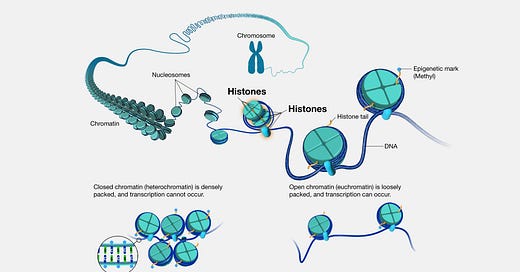Viral Histones Bridge Archaea and Eukaryotes
Viral histones are evolutionary intermediates between Archaea and Eukaryotes
Subscribe to Genomely for the latest discoveries and in-depth analyses in your inbox.
Thank you to our subscribers for your continued support and passion for science!
The origin of eukaryotic nucleosomes—which package and help regulate DNA accessibility—remains elusive. Recent research on viral histones suggests these viral proteins are evolutionary intermediates between archaeal and eukaryotic nucleosomes.
Diversity, Function, and Evolution of Viral Histones
Nicholas Irwin and Thomas Richards examined the diversity of histones encoded by Nucleocytoviricota viruses (NCVs), identifying 258 histones from 168 viral genomes. These viral histones display variable configurations, including singlets, doublets, triplets, and quadruplets. Notably, histone quadruplets consist of the four core histones (H2A, H2B, H3, and H4) arranged in series. These quadruplets comprise the core histones that package the human genome.
Phylogenetic analyses place viral histone repeats between archaeal and eukaryotic homologues. This intermediate positioning supports the hypothesis that viral histones reflect an ancient state, potentially acquired from stem eukaryotes during early embryogenesis.
In vitro experiments in the model bacterial species Escherichia coli revealed that viral histone quadruplets self-assemble into nucleosome-like structures. These viral nucleosomes can condense DNA and form archaeal-like oligomers, suggesting that viral histones possess intermediate functions bridging archaeal and eukaryotic chromatin.
Viral histones may be molecular relics from early eukaryotes, offering a unique window into the evolution of nucleosomes. This research underscores the significance of viral elements in understanding the molecular transitions that shaped eukaryotic life.
Reference
https://www.nature.com/articles/s41564-024-01707-9





